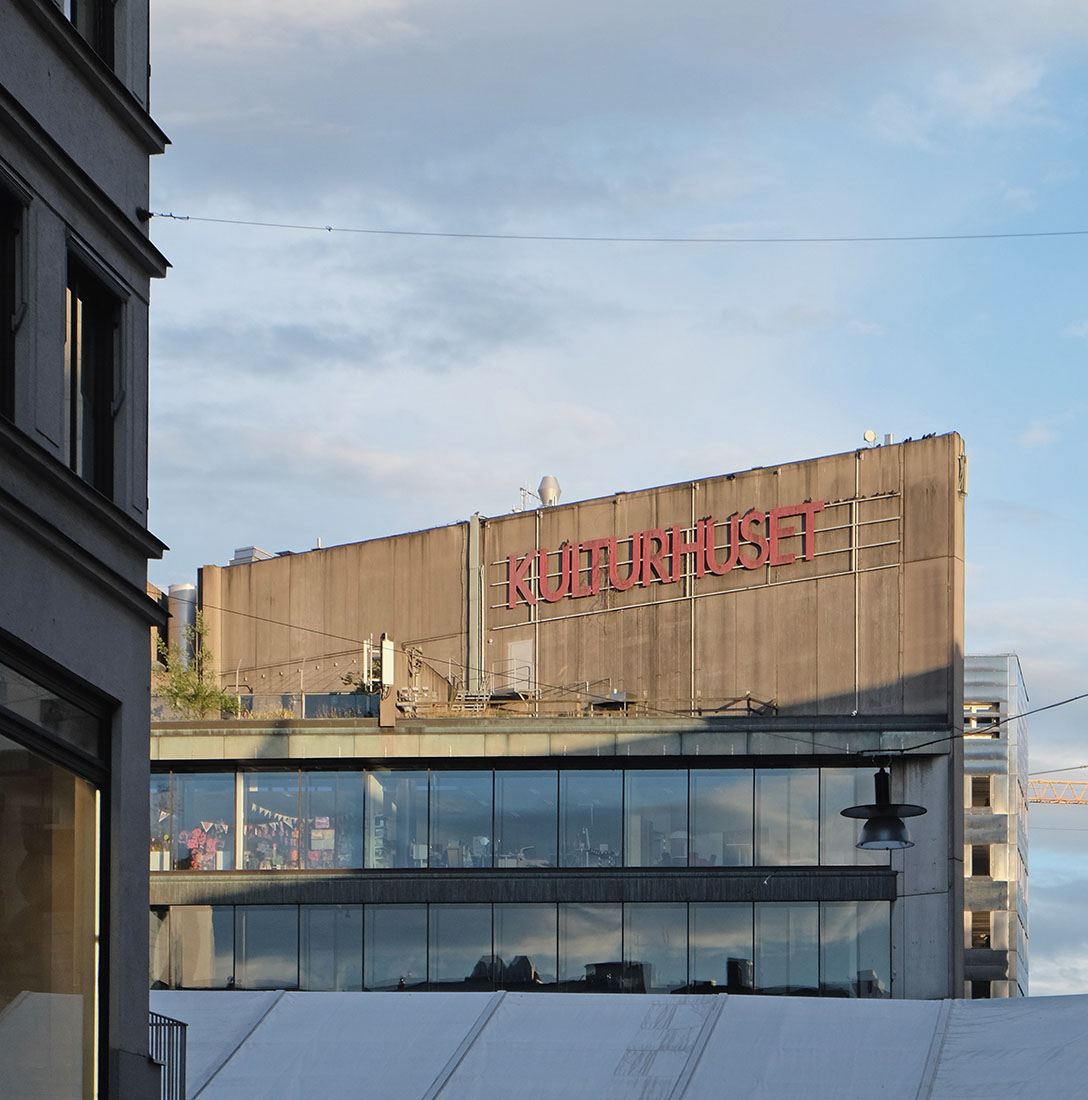 |
 |
 |
 |


Kulturhuset
Sergels Torg, Stockholm
1965 - 1974
Designed and built by Peter Celsing,
the Kulturhuset is located on Sergels Torg in Stockholm, one of the
busiest squares in the Swedish capital. This complex was conceived as a
"cultural oasis" in the new business and commercial center. In this
area of the city, from the 1950s to the early 1970s, the old
structure and architecture of Stockholm, and partly even the
topography, was almost completely replaced. The building which opened
in 1974 is considered the most famous work of Peter Celsing, apart from his sacral buildings.
Towards the Sergels Torg, the facade is mainly made of glass, so that
the building opens up to the public and gives the culture the desired
presence to the square. In contrast, the backside of this elongated
structure is completely closed. The exposed concrete structure is one
of the most striking features of this building. On the lower floor
there is an open library, on the upper floors there are rooms for
exhibitions. Originally, the Moderna Museet was intended to occupy
large parts of the building, however, the museum withdrew from these
plans in 1969. The building complex consists of two main components,
with the aforementioned concrete and glass building complemented by the
theater, which rises above a simple, square floor plan. The facades of
the theater are made of stainless steel panels, which also emphasize
the horizontal. The main façade of the square is in dialogue with Edvin
Ohrstrom's vertically rising steel-and-glass sculpture
Kristallvertikalaccent ', which is located on the square about 10
meters below.
Das von Peter Celsing entworfene und realisierte Kulturhuset befindet sich am Sergels Torg in Stockholm, einem der belebtesten Plätze in der Schwedischen Hauptstadt. Diese Anlage ist als "kulturelle Oase" im neuen Geschäftszentrum konzipiert. In diesem Bereich der Stadt wurde von den 1950er bis in die frühen 1970er Jahre die alte Struktur und Architektur von Stockholm, und teilweise selbst die Topographie beinahe komplett ersetzt. Das im Jahr 1974 eröffnete Gebäude gilt, abgesehen von seinen Sakralbauten, als bekanntestes Werk von Peter Celsing. Zum Sergels Torg hin besteht die Fassade hauptsächlich aus Glas, so dass sich das Gebäude zum Publikum öffnet und der Kultur die gewünschte Präsenz am Platz verschafft. Im Gegensatz dazu ist die Rückseite dieses langgestreckten Baukörpers komplett geschlossen. Die in Sichtbeton ausgeführte Struktur ist eines der auffallendsten Merkmale dieses Gebäudes. Im unteren Geschoss befindet sich eine offene Bibliotheke, in den oberen Stockwerken befinden sich Räume für Ausstellungen. Ursprünglich solte das Moderna Museet grosse Teile des Gebäudes besetzen, allerdings zog sich das Museum 1969 von diesen Plänen zurück. Der Gebäudekomplex besteht aus zwei Hauptbestandteilen, dabei wird das erwähnte Gebäude aus Beton und Glas ergänzt durch das Theater, welches sich über einem einfachen, quadratischen Grundriss erhebt. Die Fassaden des Theaters bestehen aus rostfreien Stahlpanelen, wleche ebenfalls die Horizontale betonen. Die Hauptfassade zum Platz steht im Dialog mit der vertikal aufstrebenden Stahl-Glas Skulptur Kristallvertikalaccent' von Edvin Ohrstrom, welche sich auf dem rund 10 Meter tiefer liegenden Platz befindet.
Das von Peter Celsing entworfene und realisierte Kulturhuset befindet sich am Sergels Torg in Stockholm, einem der belebtesten Plätze in der Schwedischen Hauptstadt. Diese Anlage ist als "kulturelle Oase" im neuen Geschäftszentrum konzipiert. In diesem Bereich der Stadt wurde von den 1950er bis in die frühen 1970er Jahre die alte Struktur und Architektur von Stockholm, und teilweise selbst die Topographie beinahe komplett ersetzt. Das im Jahr 1974 eröffnete Gebäude gilt, abgesehen von seinen Sakralbauten, als bekanntestes Werk von Peter Celsing. Zum Sergels Torg hin besteht die Fassade hauptsächlich aus Glas, so dass sich das Gebäude zum Publikum öffnet und der Kultur die gewünschte Präsenz am Platz verschafft. Im Gegensatz dazu ist die Rückseite dieses langgestreckten Baukörpers komplett geschlossen. Die in Sichtbeton ausgeführte Struktur ist eines der auffallendsten Merkmale dieses Gebäudes. Im unteren Geschoss befindet sich eine offene Bibliotheke, in den oberen Stockwerken befinden sich Räume für Ausstellungen. Ursprünglich solte das Moderna Museet grosse Teile des Gebäudes besetzen, allerdings zog sich das Museum 1969 von diesen Plänen zurück. Der Gebäudekomplex besteht aus zwei Hauptbestandteilen, dabei wird das erwähnte Gebäude aus Beton und Glas ergänzt durch das Theater, welches sich über einem einfachen, quadratischen Grundriss erhebt. Die Fassaden des Theaters bestehen aus rostfreien Stahlpanelen, wleche ebenfalls die Horizontale betonen. Die Hauptfassade zum Platz steht im Dialog mit der vertikal aufstrebenden Stahl-Glas Skulptur Kristallvertikalaccent' von Edvin Ohrstrom, welche sich auf dem rund 10 Meter tiefer liegenden Platz befindet.